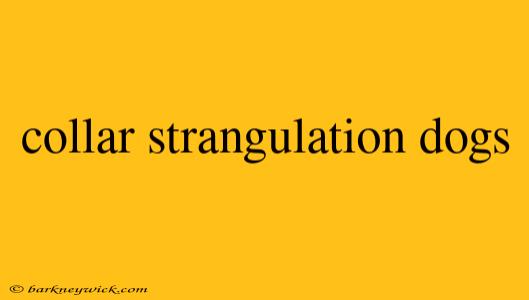The Danger of Collar Strangulation in Dogs: Understanding the Risks and Finding Safer Alternatives
Remember that time I took my puppy, Luna, for a walk? She was so excited she was practically pulling me along, and I, in my haste to keep up, ended up yanking her leash hard. I felt terrible afterward – she yelped and her eyes widened in fear. That moment made me realize how easily a simple dog collar could become a dangerous tool if not used responsibly.
It's a common misconception that collars are just for aesthetics or identifying your dog. In reality, collars can pose a serious threat if they're not properly fitted and used. In my opinion, many owners simply don't understand the risks associated with collar strangulation.
The Risks of Collar Strangulation: More Than Just a Choke
While a quick tug on a collar might seem harmless, the truth is, collar strangulation can cause a range of injuries, both immediate and long-term.
- Immediate Injuries: Coughing, gagging, difficulty breathing, and even collapse.
- Long-Term Injuries: Tracheal collapse, vocal cord paralysis, thyroid damage, and even death in extreme cases.
According to a study published in the Journal of the American Veterinary Medical Association, collar strangulation is a leading cause of emergency veterinary visits in dogs. This is why understanding the potential dangers and taking precautions is crucial.
Identifying the Warning Signs of Collar Strangulation
It's essential to recognize the signs of collar strangulation in dogs:
- Coughing or gagging: This could indicate that the collar is pressing on the trachea.
- Difficulty breathing: If your dog struggles to catch its breath or makes a wheezing sound, it might be a sign of airway obstruction.
- Vocal cord paralysis: A change in barking or difficulty making any sound could be a warning.
- Panic and fear: A dog might panic and pull against the collar if it's uncomfortable or restricted.
If you notice any of these signs, loosen or remove the collar immediately. Contact your veterinarian for advice and further evaluation.
Choosing Safer Alternatives: Harnessing the Power of Safety
It's time to rethink the collar and embrace safer alternatives. Harnessing systems offer a more secure and comfortable fit, distributing pressure away from the delicate neck.
Popular harness types:
- H-harness: Distributes pressure evenly across the chest and back.
- Step-in harness: Easy to put on and take off.
- No-pull harness: Discourages pulling by redirecting pressure to the chest.
When choosing a harness:
- Fit: Ensure it fits snugly but comfortably, allowing room for movement and breathing.
- Material: Opt for breathable and durable material.
- Design: Select a design that distributes pressure evenly and avoids constricting the dog's neck.
Investing in a proper harness from a reputable brand like Ruffwear or Kurgo will go a long way in keeping your canine companion safe and happy.
The Importance of Training: Teaching Your Dog Gentle Manners
While harnesses offer a safer alternative, responsible dog ownership also involves training. Teaching your dog to walk calmly on a leash is crucial to prevent pulling and potential strangulation risks.
Tips for leash training:
- Positive reinforcement: Reward your dog with treats and praise for walking calmly beside you.
- Consistent training: Practice regularly in short sessions.
- Professional help: Consult a certified dog trainer if needed.
Remember, patience and consistency are key to successful training.
Conclusion
As my experience with Luna highlighted, a simple dog collar can be a source of potential danger if not used responsibly. By understanding the risks of collar strangulation, choosing safer alternatives like harnesses, and investing in training, we can ensure our furry friends enjoy safe and comfortable walks. Always remember, a well-fitting harness and gentle training are the keys to a happy and healthy dog.
